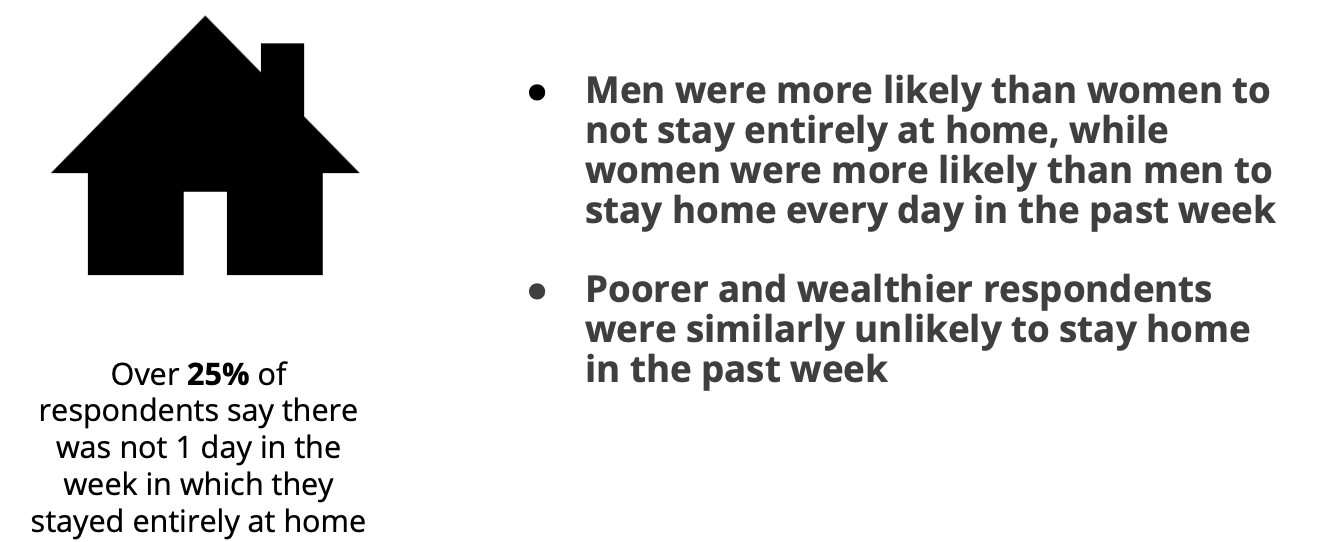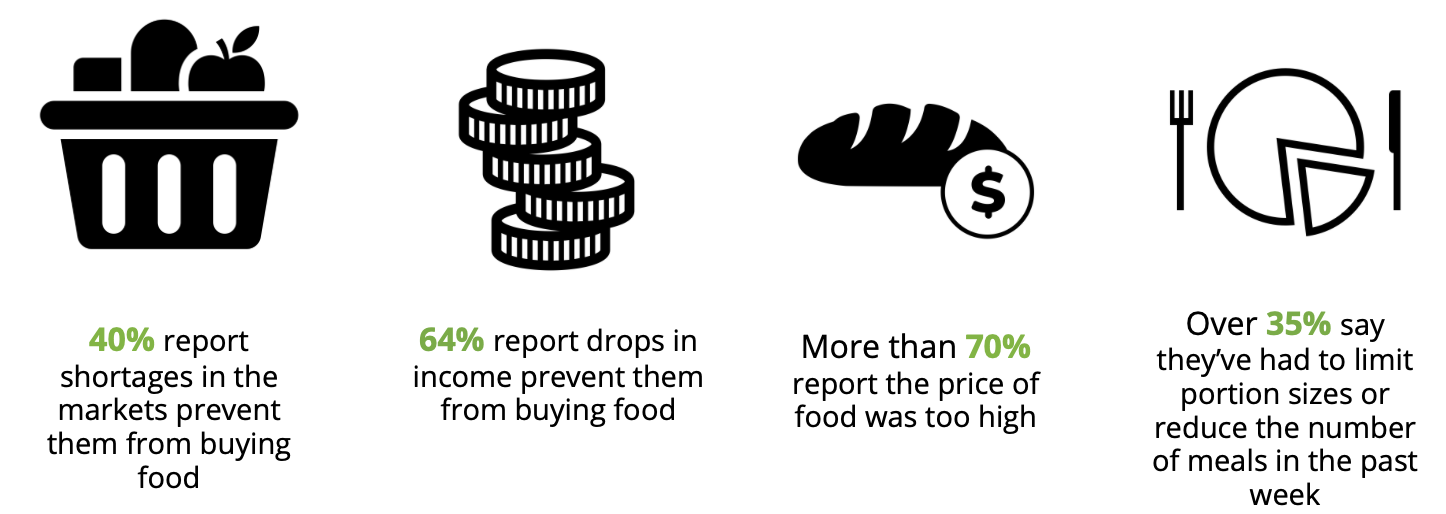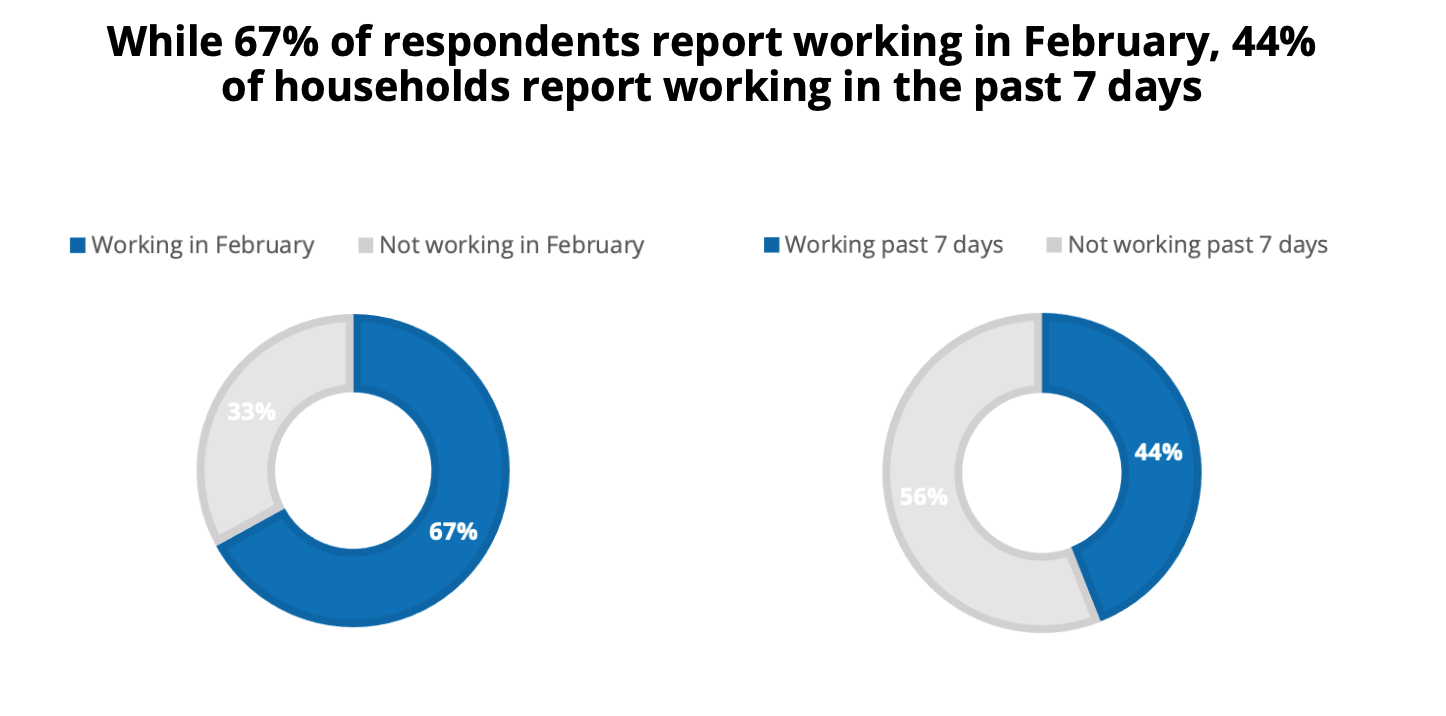Zambia RECOVR Survey Results and Policy Priorities: Identifying Evidence-Based Social Protection Strategies for an Inclusive and Equitable Recovery
By Dr. Andrew Silumesii, Besnart Simunchembu Kangalu, Tamara Billima-Mulenga, and Luciana Debenedetti
In a survey of residents in Zambia, IPA found that educational continuity, economic well-being, and food security are critical issues amidst the COVID-19 pandemic. Policymakers must contend with twin concerns of continuing to promote risk-mitigation to reduce community spread of the virus while designing an equitable economic recovery that addresses malnutrition, better incorporates informal workers into government assistance, and mitigates learning losses. Read on for detailed takeaways and policy implications for understanding the impacts of COVID-19 in Zambia.
It took until the end of April for Zambia to cross the 100-case count threshold, but steady increases since then resulted in more than 15,000 cases by mid-October. The country moved to institute a partial lockdown from March 20-May 8, closed public schools on March 20, and made masks compulsory starting mid-April. Such measures are critical for public health and affect every sphere of society.
To support policymakers with timely data on the impacts of COVID-19 in Zambia, IPA conducted the RECOVR survey from June 15-July 6.1 We found that food security, educational progress, and livelihoods are priorities for Zambians, amidst the backdrop of continuing to protect themselves against the virus. Government responses must equitably address structural constraints, with the informal work sector, high poverty and inequality, and dependence on commodity exports to embark on economic recovery.
Read on for detailed takeaways and policy implications. More information about the RECOVR survey, a cross-country panel survey that is tracking the socioeconomic impacts of COVID-19 over time in ten countries, is available here.
Zambians largely heed virus mitigation protective measures, even if less than half perceived they are at-risk
Respondents in our sample have taken COVID-19 mitigation strategies seriously and gauged their risk based on their adherence to such protective measures. For example, nearly 80 percent of respondents indicated washing their hands more often in the week they were surveyed compared to mid-March. In addition, 80 percent of respondents said that they had worn a homemade (cloth) face mask or other (nose and mouth) covering in public for the past seven days. Less encouragingly, only 15 percent of respondents stayed home all seven days in the week prior to the survey, and over 25 percent indicated there was not one day in the week in which they stayed entirely at home.

Forty percent of respondents reported that they felt their household was at-risk of contracting COVID-19, which, as Dr. Andrew Silumesii (Director of Public Health and Research, Ministry of Health) noted during our recent webinar, suggests that the government needs to double down on community engagement and risk communications to continue to convey the importance of protection measures to mitigate community spread. Tellingly, for those who did not feel at risk, over 90 percent of those respondents indicated it is because they follow preventive measures, suggesting that there is a base for the government to build on its public health communications. Despite high compliance with mask usage and hand washing, it is possible that other household or socioeconomic conditions (for example, crowded living quarters, informal employment that makes working or staying at home difficult, etc.) hamper respondents’ ability to engage in further risk mitigation, causing them to feel that their household is at risk.

There have been widespread declines in financial well-being and food security
The survey revealed a dire picture of financial strain in Zambia, exacerbated by the fact that one out of two Zambians lived below the poverty line before the pandemic. Over 50 percent of respondents indicated having had to deplete savings to pay for food, healthcare, or other expenses since February 2020, and more than 70 percent said they have had difficulty buying the amount of food they usually buy because the price of food was too high. In addition, 20 percent of respondents indicated that they could not come up with 800 kwacha (about USD $13) within the next 30 days for an emergency.
All these data points suggest that the economic effects from the pandemic and associated closures and slowdowns have had fast and deep effects on the livelihoods of Zambians. Not surprisingly, poorer respondents were more likely to say that they’d be unable to come up with these funds, and more likely to sell assets than their wealthier counterparts. Women also were more likely to say they’d be unable to access money for emergencies, and more likely to rely on family and social networks for such assistance.
Accordingly, food security is also suffering as a result of financial instability and uncertainty. Over 35 percent of respondents said they have had to limit portion sizes at mealtimes or reduce the number of meals at least once in the past week. Almost 80 percent of respondents said they have had difficulty buying the variety of food they usually buy because the price of food was too high. We also see that families with school-age children were consistently more likely than those without to report limiting portion sizes at mealtimes or reducing the number of meals all seven days in the past week. This is a very worrisome finding, given the effects that food insecurity can have on early childhood development. For example, a recent study in Ghana found that even transitory spells of food insecurity (defined as persistent food insecurity over one year of a three-year period) were associated with decreased numeracy, short-term memory, and self-regulation skills.
Over 35 percent of respondents said they have had to limit portion sizes at mealtimes or reduce the number of meals at least once in the past week. Almost 80 percent of respondents said they have had difficulty buying the variety of food they usually buy because the price of food was too high.

Livelihoods and employment have taken a hit, and the government is ramping up its response
The Zambian economy is likely headed for a recession (the first time in more than twenty years) and our survey sheds light on the onset of such a downturn. Though almost 50 percent of households’ places of work were open with business as usual, more than 50 percent of employed individuals spent fewer hours working than they did in a typical week before the government closed schools, and more than 50 percent of employed individuals earned less pay than they typically did before the government closed schools.

The government (in partnership with UNICEF and the World Bank) launched an emergency cash transfer on July 28th, whose effect was not captured in the survey as the transfer took place after the survey was implemented. The transfer is aimed at the elderly, women, and children, and consists of a K400 monthly transfer for six months, set to reach 656,000 households. In our sample, almost no households received food or cash from the government in response to COVID-19. Furthermore, more vulnerable groups of the population (women, poorer respondents, families with school-age children) were no more likely to receive assistance from the government. Subsequent rounds of the survey will shed light on the targeting effectiveness of the government’s emergency response and other expanded social assistance programs.
Students face many barriers with distance education and parents were worried about learning loss
Parents in Zambia are feeling the strain from school closures and education interruptions. Only 30 percent of respondents indicated that their primary school students are spending more than 2 hours per day on education. For secondary school students, almost 40 percent were spending more than two hours per day on education. Even so, comparable to a daily, six hours in the normal school year, these answers indicate much less time spent on school since the beginning of the pandemic.
When asked if they would re-enroll their students once schools re-open, almost 80 percent of households indicate they would have their students return—perhaps an indication of the frustrations with the experience of distance learning, though we do not have information regarding their motivations.

In terms of materials and mediums for distance learning, a majority of students utilized their own school books (for both primary and secondary school students). Not surprisingly, wealthier students were more likely to report access to and usage of educational content on the internet. In terms of barriers to spending time on education at home, respondents cited lack of motivation, lack of support from teachers and schools, and lack of access to television. In terms of lack of support from teachers and schools, accordingly, less than 25 percent of respondents reported that they have been contacted by anyone from their child’s school since schools have closed.
In our webinar, Ms. Besnart Simunchembu Kangalu (Principal Planner, Ministry of General Education) highlighted the interventions that the Ministry of General Education instituted during school closures:
- The establishment and launch of an e-learning portal
- The establishment of a new educational television channel that televises early childhood, primary, and secondary education and guidance counseling programs (including sign language interpretation to engage learners with special needs)
- Educational radio lessons (over 1,000 lessons have been developed and recorded for early childhood, primary, and junior secondary levels)
- Printing/distribution of self-instruction materials for secondary education
Ms. Simunchembu Kangalu acknowledged that the RECOVR survey demonstrated to the Ministry the importance of better dissemination and advertising of the various modes of education available to learners through Alternative Modes of Education Delivery (AMEP) for distance education. She also indicated that the Ministry would be engaging teachers in small groups to promote better communication with parents, a clear gap in learners’ educational experiences identified by the survey.
Policy Implications: Rising to Meet the Moment
The findings from the RECOVR survey suggest that there is significant room for government policy to further develop a coordinated response to assist Zambians in emerging from the coronavirus crisis. The government and wider international donor community can consider the following strategies:
- Scale-up cash transfers through mobile money | Eighty percent of respondents have access to a mobile money account where they can make and receive payments, suggesting that a financial ecosystem is established in Zambia and can be harnessed for expanded government assistance. In the webinar, Dr. Silumesii called for enhanced collaboration across ministries—particularly between the Ministry of Health and Ministry of Community Development—to improve targeting of recipients and better linkage of at-risk households and individuals (such as informal workers) to social protection programs and the new national health insurance program. With the emergency cash transfer in place since the end of July, the government and donor community should continue to monitor the targeting and uptake of the program, to ensure that funds reach designated beneficiaries. Utilizing digital platforms to transfer money directly to beneficiaries can assist with effective targeting and efficacy. There is also (limited) evidence to suggest there are major cost savings associated with adopting digital delivery channels, both to the government or institution deploying the cash transfers as well as reductions in the cost of accessing the transfers on the part of the beneficiary. More information on IPA’s recommendations for key decisions around targeting, program design, and program delivery to increase social protection during COVID-19 is available here.
- Address learning losses through targeted instruction | Previous research shows a central barrier to learning is that children come into classrooms at very different levels, many unable to keep up with the curriculum. As the COVID-19 crisis is expected to widen the gap between children with access to learning resources out of school and those without, teachers are likely to return to classes with an even wider range of kids’ abilities in their classrooms, making their jobs even more difficult, and risking even more children left behind. With schools reopening in Zambia in mid-September, conducting rapid, low-stakes learning assessments as children return to school to appropriately group students into learning groups, and reinforcing foundational literacy and numeracy skills will be critical strategies to promote equitable learning for Zambian students. The Ministry of General Education’s commitment to scaling up the pre-existing Catch Up program—co-implemented by Teaching at the Right Level and VVOB—within the context of expected learning losses offers an additional opportunity to expand targeted instruction in Zambia amidst predictable learning losses. Should virus rates necessitate future school closures, the Ministry is preparing by continually seeking opportunities to improve upon their distance learning platforms and programs and enhance the utilization of these media.
- Utilize school feeding programs to promote nutrition and food security for children | While food insecurity is worrisome for any age group, the effect on children’s development is particularly harmful. Continuity of basic food access is key to mitigate further malnutrition. With many school feeding programs cut because of closures, the government can consider implementing nutritional assistance programs via in-kind transfers through delivery distribution or setting up feeding points near schools in a safe manner consistent with public health protocols. As Dr. Silumesii also noted, the large proportion of families that already report reducing meal numbers and portions is very concerning and underscores the need for the government to continue routine growth monitoring of children to detect malnutrition early and implement timely interventions.
The government can build on its previous work to address malnutrition and child stunting to address increases in food insecurity from the pandemic, for example by increasing parental knowledge and engagement through home-based growth charts that allow parents to directly compare their children’s height to the expected height range for children of the same age and provide parents with information regarding the most suitable local foods. IPA is currently collaborating with the Zambia Ministry of Health to adapt the intervention design and assess it on a large sample of Zambian children to identify a scalable model that can be applied to existing government programs.
1. We surveyed 1,278 respondents using random digit dialing of a nationally representative sample of cell phone numbers. As such, our survey is not nationally representative, and rather is representative of mobile phone coverage. The RECOVR (Research for Effective COVID-19 Responses) survey averages comprised 43% women, 31.9 years old, 80% secondary school completion rate, 5.2 people average household size, and 31% under the national poverty rate (estimated with IPA’s Poverty Probability Index). Compared to the latest national census, our survey was less female, wealthier, and older.











